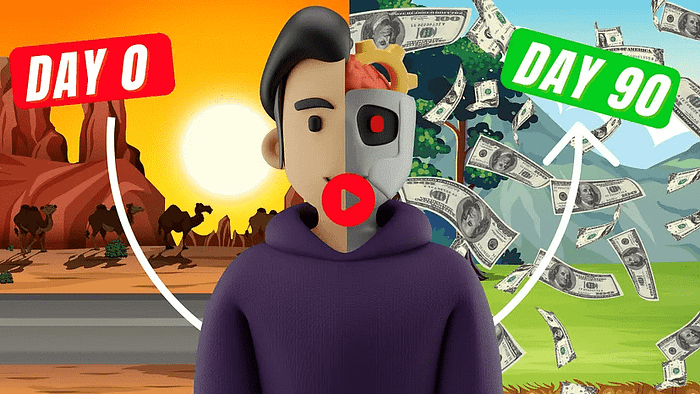How I Built a $1,000,000 Calorie Tracker App with AI in 30 Minutes
Crafting a $1,000,000 calorie tracker app with AI ignited my curiosity and pushed me to explore the limits of modern technology.
I’ve always been fascinated by how simple ideas can transform into massive successes, and today, I’m thrilled to share my journey of building an app that’s poised to rake in millions.
This isn’t just a pipe dream—apps like these are already generating jaw-dropping numbers, some hitting nearly $1 million per month.
My creation is a straightforward calorie tracker with two tabs, sleek onboarding screens, and integrations like Firebase and Open AI, all whipped together in under 30 minutes.
The tools I leaned on—Cursor, GPT-4.5, and DeepSeek—made this whirlwind process not only possible but surprisingly smooth.
What’s wilder is that I didn’t write a single line of code myself; the AI handled the heavy lifting while I guided it step-by-step.
By the end of this, you’ll see how accessible and powerful app development has become, even for someone starting from scratch.
So, let’s dive into this adventure and uncover how I turned a basic concept into a potential goldmine.
We strongly recommend that you check out our guide on how to take advantage of AI in today’s passive income economy.
Table of Contents
Laying the Groundwork for a Million-Dollar Idea
Planning with Precision
Before I even touched a keyboard, I knew planning would be the backbone of this $1,000,000 calorie tracker app with AI.
I started by jotting down every detail in a markdown file—think of it as my blueprint for success.
This document outlined the app’s core functionality: a calorie tracker with image analysis, two main tabs (home and settings), and a smooth onboarding flow to hook users right away.
It also covered technical bits like Firebase for authentication and data storage, Open AI for smart features, and the folder structure to keep everything tidy.
I’d already hashed out these ideas using ChatGPT earlier, refining them until they were crystal clear.
Having this roadmap meant I could jump into development without second-guessing, saving me heaps of time.
If you’re following along, I’ve linked this full markdown file below—it’s your cheat sheet to replicate this process effortlessly.
With my plan locked in, I felt ready to bring this million-dollar vision to life.
Setting Up the Foundation
Next, I fired up Cursor, my go-to coding assistant, to kickstart this $1,000,000 calorie tracker app with AI.
I navigated to my YouTube folder on my computer—feel free to pick any directory you like—and ran a simple command: npx create-expo-app.
This spun up a basic Expo template, a pre-built app skeleton that could technically run right out of the box.
But I didn’t want a cookie-cutter start; I wanted a clean slate, so I reset it with npm run reset-project.
This wiped out Expo’s default example, leaving me with a bare-bones app ready for customization.
Picture it like clearing a cluttered desk—you’ve got space now to build exactly what you want.
Once the reset was done, Cursor opened the fresh project, and I could feel the excitement building.
This was the moment my app started taking shape, and I was just getting warmed up.
Building the App Step by Step
Installing the Essentials
With the blank canvas ready, I moved on to loading up the tools for my $1,000,000 calorie tracker app with AI.
My markdown file listed all the dependencies—think React Navigation for tabs, Firebase SDK for backend magic, and Open AI’s API for intelligence.
I copied that list, pasted it into Cursor’s terminal, and let it install everything seamlessly.
It’s like stocking a kitchen before cooking a feast—every ingredient was now at my fingertips.
Then, I created a context.md file, pasting in all the detailed instructions from my original markdown.
This file became the AI’s playbook, guiding it through the app’s structure, from onboarding screens to image analysis features.
With dependencies installed and context set, I was ready to see some real progress.
The foundation was solid, and the real fun was about to begin.
Bringing the App to Life
Now it was time to run my $1,000,000 calorie tracker app with AI for the first time.
I typed npx expo start into the terminal, and a QR code popped up on my screen.
Using the Expo Go app on my phone, I scanned it, and boom—the app bundled and launched live.
The entry point was a simple screen saying “Welcome,” but I tweaked it to “Hello YouTube” just to test the live reload.
Sure enough, the change reflected instantly on my phone, no hiccups.
Imagine holding a freshly baked cookie, still warm—that’s how satisfying this felt.
With the app running, I opened Cursor’s composer feature and told it, “Help me build this app screen-by-screen, starting with onboarding, following context.md.”
I switched to Sonnet 3.7 for this, a newer AI model rumored to be lightning-fast, and let it work its magic.
Watching AI Take the Wheel
Here’s where my $1,000,000 calorie tracker app with AI really started to shine—or so I thought.
The AI dove in, generating files like wildfire: services, hooks, screens, the works.
At first, I’d asked for an incremental build, but it went full throttle, crafting the entire app in one go.
I could see it churning out the onboarding flow, sign-up screens, and even the tab layout—all based on my markdown.
But then, an error flashed up—Firebase wasn’t hooked up yet, which I’d expected since we hadn’t configured it.
It was like building a car without gas; the frame was there, but it wouldn’t run.
Still, I marveled at the speed—hooks for authentication, context for state management, everything was falling into place.
I knew a little cleanup was ahead, but the AI had just laid down a stunning first draft.
Integrating the Heavy Hitters
Wiring Up Firebase
To fix that error and power my $1,000,000 calorie tracker app with AI, I headed to Firebase.
I created a new project called “Calorie,” clicking through the setup until it was live.
Picture a control center lighting up—this was my app’s backend coming online.
I grabbed the Firebase SDK details, which looked like a long string of code tying everything together.
Then, I jumped to Open AI, generated a secret key (don’t worry, I deleted it post-project), and prepped both for integration.
Back in Cursor, I instructed, “Create an .env file and integrate Open AI and Firebase with these keys.”
The AI whipped up the file, slotting in the values like a pro, and linked them to the app’s services.
With Firebase authentication and Firestore database activated, my app was finally ready to roll.
Fine-Tuning the Features
Now that my $1,000,000 calorie tracker app with AI had its backbone, the AI resumed building.
It crafted the home screen—clean, minimal, ready for calorie data—and the settings tab with options like dark mode.
The onboarding flow popped up next, guiding users through sign-up and login with a polished feel.
I reloaded the app, and there it was: a login screen staring back at me, no errors in sight.
Imagine flipping on a light switch after wiring a house—it just worked.
I tested it with “test@test.com” and “123456,” and the account creation flowed smoothly, verified in Firebase’s authentication panel.
The UI looked sharp, though a pesky header lingered, which I’d tackle next.
This was starting to feel like a real, professional app, and I hadn’t typed a single line myself.
Polishing the Gem
Removing the Clutter
That header on my $1,000,000 calorie tracker app with AI was an eyesore, so I tackled it head-on.
I told Cursor, “Remove the header from all screens, but don’t overhaul the code.”
It pinpointed the navigation config, flipping headerShown to false, a quick fix.
I accepted the change, rebundled the app, and rescanned the QR code on my phone.
The result? A sleek, header-free interface that looked miles cleaner—like wiping smudges off a mirror.
Logging in again with “test@test.com” and “123456,” I admired the streamlined design.
Settings worked flawlessly, with logout functioning as expected.
This small tweak made the app feel premium, and I was grinning ear to ear.
Testing the Magic—Image Analysis
The real test for my $1,000,000 calorie tracker app with AI was the image analysis feature.
I clicked “Take a Picture,” snapped a shot of some Doritos, and held my breath.
The app processed it, spitting out calories, protein, carbs, and fat—right there on the home screen.
It wasn’t perfect; the image didn’t save to Firebase Storage (a paid upgrade thing), but the analysis nailed it.
Picture a nutrition label appearing out of thin air—that’s the vibe.
I tried selecting a preloaded image next, and the data populated just as cleanly.
Dark mode toggled like a dream, and the UI felt intuitive, almost pro-level.
This was the million-dollar moment, and it was working better than I’d dared hope.
Wrapping Up a Million-Dollar Masterpiece
Final Touches and Reflections
With my $1,000,000 calorie tracker app with AI nearly complete, I tested account deletion.
Using “test@test.com,” I hit delete, and Firebase confirmed it was gone—another win.
The app now had onboarding, login, calorie tracking via image analysis, and a settings tab, all in under 30 minutes.
I hadn’t coded a thing; Cursor, GPT-4.5, and DeepSeek did it all, guided by my markdown.
It’s like hiring a team of genius developers who work for free and finish in record time.
Sure, the image storage needs a tweak, but the core is rock-solid.
You could take this, enhance the UI, add features, and scale it to millions—I’ve shown you the starting line.
This journey proved app development isn’t just for coders anymore; it’s for dreamers with the right tools.
What’s Next for You
My $1,000,000 calorie tracker app with AI is yours to play with—everything’s linked below.
Go in, tweak it, make it fancier, or dream up something entirely new.
The point was to show how fast and easy this can be with AI at your side.
Imagine adding push notifications, social sharing, or a premium subscription tier—sky’s the limit.
I’m still buzzing from seeing it come together, from a markdown file to a functional app.
This isn’t just about calories; it’s about unlocking potential with tools like Firebase and Open AI.
So, grab this blueprint, start building, and who knows—you might just create the next big thing.
Peace out, and happy coding—or should I say, happy creating!

We strongly recommend that you check out our guide on how to take advantage of AI in today’s passive income economy.



